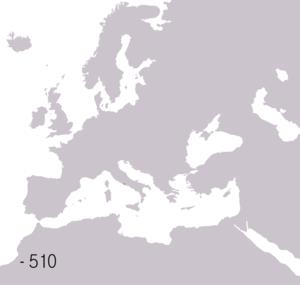By 476 AD, when Odoacer deposed the Emperor Romulus, the Western Roman Empire wielded negligible military, political, or financial power and had no effective control over the scattered Western domains that could still be described as Roman. Invading "barbarians" had established their own polities on most of the area of the Western Empire. While its legitimacy lasted for centuries longer and its cultural influence remains today, the Western Empire never had the strength to rise again. One hundred years previously, in 376 AD, large numbers of Goths crossed the Danube River. They sought admission to the territory of the Roman Empire, a political institution which, despite both new and longstanding systematic weaknesses, wielded effective power across the lands surrounding the Mediterranean and beyond. The Empire had large numbers of trained, supplied, and disciplined soldiers, it had a comprehensive civil administration based in thriving cities with effective control over public finances, and it maintained extreme differences of wealth and status (including slavery on a large scale). It had wide-ranging trade networks that allowed even modest households to use goods made by professionals a long way away. Among its literate elite it had ideological legitimacy as the only worthwhile form of civilization and a cultural unity based on comprehensive familiarity with Greek and Roman literature and rhetoric.The events of the decline became the subject of debate at the time, which often took on a strongly religious flavor. Like the events surrounding the fall of the Roman Republic, much of this period is unusually well-documented, though there are very few statistics which directly describe the strength of the economy, of the army, of the civil administration, or of the barbarians. Modern historians nevertheless debate the relative importance of these and other factors, in particular, whether the state was significantly weaker by 376 than it had been in previous centuries, and why the West collapsed while the East did not. The collapse, and the repeated attempts to reverse it, are major subjects of the historiography of the ancient world and they inform much modern discourse on state failure.




Comentar
0